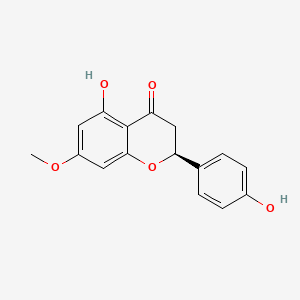| MeSH term | MeSH ID | Detail |
|---|---|---|
| Acne Vulgaris | D000152 | 35 associated lipids |
Sakuranetin
Sakuranetin is a lipid of Polyketides (PK) class. Sakuranetin is associated with abnormalities such as and Neurodegenerative Disorders. The involved functions are known as inhibitors, Drug Interactions, aldehyde reductase activity, Antiinflammatory Effect and antagonists. Sakuranetin often locates in Vacuole and Cell surface. The associated genes with Sakuranetin are PTPN1 gene.
Cross Reference
Introduction
To understand associated biological information of Sakuranetin, we collected biological information of abnormalities, associated pathways, cellular/molecular locations, biological functions, related genes/proteins, lipids and common seen animal/experimental models with organized paragraphs from literatures.
What diseases are associated with Sakuranetin?
Sakuranetin is suspected in Neurodegenerative Disorders and other diseases in descending order of the highest number of associated sentences.
Related references are mostly published in these journals:
| Disease | Cross reference | Weighted score | Related literature |
|---|
Possible diseases from mapped MeSH terms on references
We collected disease MeSH terms mapped to the references associated with Sakuranetin
PubChem Associated disorders and diseases
What pathways are associated with Sakuranetin
There are no associated biomedical information in the current reference collection.
PubChem Biomolecular Interactions and Pathways
Link to PubChem Biomolecular Interactions and PathwaysWhat cellular locations are associated with Sakuranetin?
Visualization in cellular structure
Associated locations are in red color. Not associated locations are in black.
Related references are published most in these journals:
| Location | Cross reference | Weighted score | Related literatures |
|---|
What functions are associated with Sakuranetin?
Related references are published most in these journals:
| Function | Cross reference | Weighted score | Related literatures |
|---|
What lipids are associated with Sakuranetin?
There are no associated biomedical information in the current reference collection.
What genes are associated with Sakuranetin?
Related references are published most in these journals:
| Gene | Cross reference | Weighted score | Related literatures |
|---|
What common seen animal models are associated with Sakuranetin?
There are no associated biomedical information in the current reference collection.
NCBI Entrez Crosslinks
All references with Sakuranetin
Download all related citations| Authors | Title | Published | Journal | PubMed Link |
|---|---|---|---|---|
| pmid: | ||||
| Nakazato Y et al. | Methionine-induced phytoalexin production in rice leaves. | 2000 | Biosci. Biotechnol. Biochem. | pmid:10803956 |
| Ahmed MS et al. | A weakly antimalarial biflavanone from Rhus retinorrhoea. | 2001 | Phytochemistry | pmid:11576606 |
| Tuchinda P et al. | Anti-inflammatory cyclohexenyl chalcone derivatives in Boesenbergia pandurata. | 2002 | Phytochemistry | pmid:11809452 |
| Ibrahim AR et al. | O-demethylation and sulfation of 7-methoxylated flavanones by Cunninghamella elegans. | 2003 | Chem. Pharm. Bull. | pmid:12576658 |
| Obara N et al. | Induced volatiles in elicitor-treated and rice blast fungus-inoculated rice leaves. | 2002 | Biosci. Biotechnol. Biochem. | pmid:12596847 |
| Danelutte AP et al. | Antifungal flavanones and prenylated hydroquinones from Piper crassinervium Kunth. | 2003 | Phytochemistry | pmid:12943774 |
| Ugocsai K et al. | Effects of selected flavonoids and carotenoids on drug accumulation and apoptosis induction in multidrug-resistant colon cancer cells expressing MDR1/LRP. | 2005 Mar-Apr | In Vivo | pmid:15796208 |
| Jung YH et al. | The rice (Oryza sativa) blast lesion mimic mutant, blm, may confer resistance to blast pathogens by triggering multiple defense-associated signaling pathways. | 2005 | Plant Physiol. Biochem. | pmid:15907692 |
| Rivero-Cruz I et al. | Antimycobacterial agents from selected Mexican medicinal plants. | 2005 | J. Pharm. Pharmacol. | pmid:16105233 |
